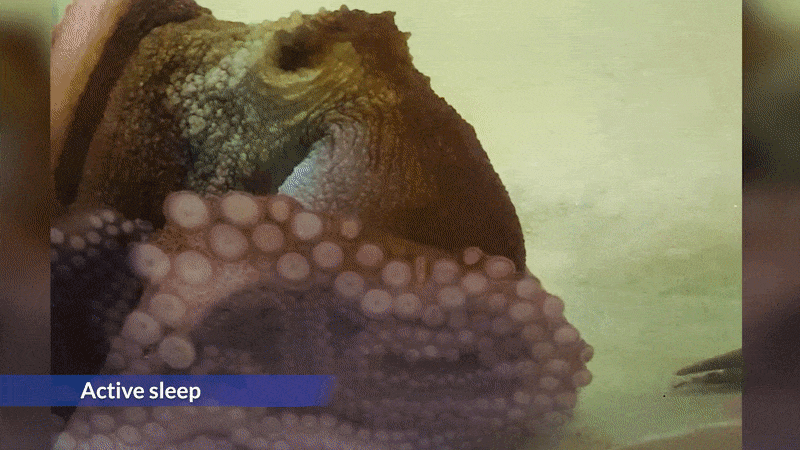Do octopuses dream of 8-armed sheep? New study hints at human-like sleep cycle in cephalopods

When octopuses snooze on the seafloor, their skin sometimes pulses with an array of colors, and at other times, they become pale and plain. These alternating patterns mark two distinct stages of the octopus sleep cycle, a small study suggests.
During "active sleep," when an octopus's skin ripples with dazzling colors, the cephalopod may experience something similar to our rapid-eye movement (REM) sleep, the authors wrote in the study, published March 25 in the journal iScience. Humans do most of their dreaming during REM sleep, but for now, we don't know if cephalopods also drift off to dreamland — or what they'd dream about, if they did.
"This whole speculation about dreaming, we must take it with caution," said senior author Sidarta Ribeiro, a neuroscientist at the Brain Institute of the Federal University of Rio Grande do Norte, Brazil. He noted that the octopus's episodes of active sleep occur in brief bursts, lasting from a few dozen seconds to just over a minute.
Related: 8 crazy facts about octopuses
"In mammals ... the active sleep, what we call REM sleep is much longer. It lasts minutes, dozens of minutes," Ribeiro told Live Science. So, "even if there is ... some sort of inner narrative going on in the octopus's mind as it's going through active sleep, it's very unlikely that it's a whole story," he said. More likely, an octopus might dream in short scenes, like video clips pulled from a longer movie, he said.
But even if octopuses don't dream during these fleeting moments of active sleep, the sleep state may still play an important role in the creatures' learning and memory, similar to how human memories become reinforced during REM, Ribeiro said. The authors plan to study the influence of different sleep states on octopus learning in the future.
Psst, are you asleep?
Octopuses change color using chromatophores, or specialized pigment organs that expand and contract under the skin, altering the colors and patterns on its surface, Live Science previously reported. While awake, octopuses can change color to blend in with their surrounding environment, but it's unknown why the animals continue to shift color while at rest, and few studies of octopus sleep have explored the phenomenon.
Get the world’s most fascinating discoveries delivered straight to your inbox.
In past studies of the common octopus (Octopus vulgaris), scientists have only described so-called "quiet sleep," when the animal sits very still and its skin turns a ghostly white color, first author Sylvia Medeiros, a doctoral student at the Brain Institute, told Live Science. The vibrant, "active" sleep state has been described more thoroughly in the common cuttlefish (Sepia officinalis), a related cephalopod, but these studies didn't check whether the cuttlefish were truly asleep or just in a "state of quiet alertness," Medeiros noted in the iScience report.
To confirm that an animal is truly asleep, scientists test its "arousal threshold," meaning the amount of time it takes the creature to react to a stimulus. For example, while awake, an octopus will quickly react to physical vibrations of its tank or to videos of scuttling crabs played just outside the glass. A sleeping octopus will take far longer to react, or may not respond at all, since it must first be roused from slumber.
Related: Why do people 'twitch' when falling asleep?
The team conducted these arousal experiments with four tropical octopuses of the species Octopus insularis, which Medeiros collected 6 miles (9.7 kilometers) from their lab in Brazil. The authors captured video recordings of the octopuses to assess their behavior while alert and at rest. Noting patterns in the cephalopods' behavior, they then tested the animals' arousal thresholds in different behavioral states; for instance, they tested the animals both when they were alert and exploring their tanks and when they became still and appeared to rest.
The researchers found that the octopuses are not only genuinely sleeping during active sleep, but the animals also switch between quiet and active sleep in a predictable pattern.
"The relationship between quiet and active sleep that they identified is particularly exciting," said Sara Stevens, an aquarist with Butterfly Pavilion in Westminster, Colorado, who was not involved in the study. "It verifies patterns we've anecdotally witnessed across the octopuses we've had in our care over the years," Stevens told Live Science in an email. However, since the new work only included four octopuses of the same species, larger studies will be needed to confirm the results, she noted.
A distinct sleep pattern
The team observed that colors disappear from the octopuses' skin during "quiet sleep," and their pupils contract into thin slits. In this state, the animals become quite still except for the occasional soft, slow movements of their suckers and arm tips. Periods of quiet sleep can last from a few minutes to about half an hour.
"Quiet sleep pretty much always precedes the active sleep," Ribeiro said. "It's usually the long quiet sleep episodes," lasting more than six minutes, "that lead to an active sleep episode," he added.
A dramatic visual change marks the shift between quiet and active sleep. The chromatophores on the octopus's head and mantle — the bulbous structure that houses the animal's organs — display "sudden simultaneous darkening." The animal then begins twitching, contracting its suckers, moving its eyes and increasing its ventilation rate. The octopus also expands and contracts its pupils, while vibrant colors wash over its whole body.
Though its pupils sometimes dilate, the octopus doesn't react to visual stimuli in this state — similar to how a person can sleep with their eyes open. These sudden bouts of movement and color occur periodically, at roughly 30- to 40-minute intervals.
"It really resembles what you see in reptiles and birds: Long, quiet sleep followed by short, brief episodes of active sleep," Ribeiro said. Mammalian sleep follows a similar pattern but the active sleep, namely REM, typically lasts longer than in other animals, he said.
Related: 7 mind-bending facts about dreams
In mammals, the shift into REM sleep is accompanied by physiological changes that help convert short-term memories into long-term memories in the brain, Ribeiro noted. It's still unclear whether active sleep serves a similar purpose in birds or reptiles, and in the case of octopuses, we have no clue, he said.
The authors plan to study whether changes in an octopus's sleep cycle affect its ability to learn new tasks; for instance, they may study how well sleep-deprived octopuses can learn and remember how to free food from closed containers. In addition to behavioral tests, the team plans to study whether octopuses express specific genes or build particular proteins during active sleep, as mammals do during REM.
At some point, they also hope to record the electrical activity of octopus neurons during sleep, but that presents an incredible challenge, the authors said. For starters, the squishy, boneless creatures lack solid body parts that scientists could easily attach electrodes to, Ribeiro said. What's more, the curious animals tug and pull at anything placed on their bodies, Medeiros said.
"Adding water into the equation takes it to a completely different level of difficult," Stevens added.
Among these many challenges, a huge question still remains: Do octopuses dream or not?
"My hunch is yes, but we are open to everything," Ribeiro said.
Until the team can collect neural recordings from octopuses, it may be possible to study their theoretical dreams by taking detailed recordings of the colors and patterns on their skin, he noted. If an octopus dons a certain color scheme during sleep that corresponds to a behavior in its waking life, such as courtship, that could potentially provide a window into what the animal is dreaming about. The scenario is similar to observing a dog growl and twitch in its sleep, as if dreaming of chasing rabbits.
But again, using pigment patterns to read octopus dreams may be a reach at this point, as more research is needed to understand octopus sleep states at a fundamental level, Ribeiro said.
Originally published on Live Science.

Nicoletta Lanese is the health channel editor at Live Science and was previously a news editor and staff writer at the site. She holds a graduate certificate in science communication from UC Santa Cruz and degrees in neuroscience and dance from the University of Florida. Her work has appeared in The Scientist, Science News, the Mercury News, Mongabay and Stanford Medicine Magazine, among other outlets. Based in NYC, she also remains heavily involved in dance and performs in local choreographers' work.


